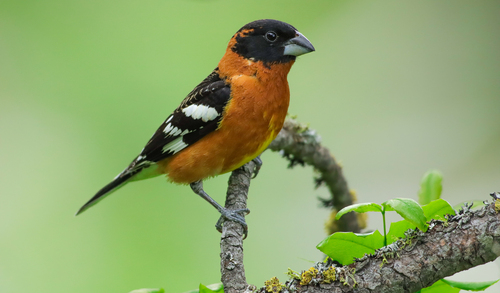
Black-headed Grosbeak
The Black-headed Grosbeak ( *Pheucticus melanocephalus*) is a striking, medium-sized songbird known for its vibrant plumage and melodious song. It plays a significant role in its ecosystem as both a seed disperser and an insect predator, contributing to the health of forests and woodlands. While not holding major cultural significance in the same way as some iconic birds, its beauty and song are appreciated by birdwatchers and nature enthusiasts across its range. It is a member of the Cardinalidae family, which includes cardinals, buntings, and other grosbeaks.
18-21 cm
Length
30-33 cm
Wingspan
Least Concern
Conservation Status
Distribution
The Black-headed Grosbeak breeds across western North America, from southwestern British Columbia and southern Alberta in Canada, south through the western United States, and into central Mexico. It migrates south for the winter, with the majority of the population wintering in Mexico. Its altitudinal range extends from sea level to over 3,000 meters.
Lifespan
Up to 8 years in the wild, potentially longer in captivity (though data on captive lifespan is limited).
Black-headed Grosbeak's Habitat
Habitat Types
Deciduous woodlands, Mixed forests, Riparian corridors, Oak savannahs, Parks and gardens
Climate Zones
Temperate, Subtropical
Adaptations
The Black-headed Grosbeak's strong, conical bill is well-adapted for cracking seeds and crushing hard-bodied insects. Its preference for edge habitats allows it to exploit resources from both open areas and forest interiors.
Variations
Two subspecies are generally recognized: *P. m. melanocephalus* in the western part of the range and *P. m. maculatus* in the eastern part. These subspecies differ slightly in plumage and bill size, reflecting minor adaptations to local environments.
Appearance
Breeding Plumage
Males in breeding plumage have a black head, orange breast and underparts, black wings with white patches, and a black tail. Non-breeding males are duller. Females have a streaked brown head, a buffy-orange breast, and brown wings with white wing bars.
Seasonal Feather Changes
Males undergo a molt after breeding, resulting in a duller, more female-like plumage during the non-breeding season. They regain their bright breeding plumage in the spring.
Sex Based Plumage Differences
Significant. Males are brightly colored, while females are more cryptic, providing camouflage during nesting.
Notable Features
Large, conical bill, Bold white wing patches (especially prominent in males), Orange or buffy-orange breast, Black head in breeding males
Diet and Feeding
Primary Foods
Insects, Seeds, Fruits, Berries
Foraging Behavior
Black-headed Grosbeaks forage in trees and shrubs, gleaning insects from leaves and branches. They also hop on the ground to pick up seeds and fallen fruit. They often visit bird feeders, particularly those offering sunflower seeds.
Specializations
Their strong bill is a key specialization, allowing them to crack open a wide variety of seeds and consume hard-bodied insects that other birds might avoid.
Seasonal Diet Variations
Their diet shifts seasonally. During the breeding season, they primarily consume insects, providing protein for themselves and their young. In the fall and winter, they rely more heavily on seeds and fruits.
Behavior
Social Structure
Generally solitary or in pairs during the breeding season. Forms small flocks during migration and in wintering areas.
Communication
Complex, melodic song, often described as a robin-like warble., Sharp 'pik' call note, used for alarm or contact., Visual displays, such as wing fluttering and tail spreading.
Migration
Black-headed Grosbeaks are migratory, traveling south to Mexico and Central America for the winter. They migrate at night, navigating using stars and the Earth's magnetic field. Migration is triggered by changes in day length and food availability.
Territorial or Group Behaviors
Males defend territories during the breeding season, using song and aggressive displays to ward off rivals. Outside of the breeding season, they are less territorial and may form small foraging flocks.
Conservation
Threats
Habitat loss and fragmentation (due to agriculture, urbanization, and logging), Pesticide use (reducing insect prey), Climate change (potentially altering breeding and migration patterns)
Protection Programs
Migratory Bird Treaty Act (in the US and Canada), Habitat conservation efforts by various organizations (e.g., Audubon Society, The Nature Conservancy)
Local National Laws
Protected under the Migratory Bird Treaty Act in the US and Canada, and similar legislation in Mexico.
Population Trend
Stable
Population Estimates
Estimated global population of 11,000,000.
Interesting Facts
They can eat toxic monarch butterflies.
Black-headed Grosbeaks are one of the few bird species that can tolerate the toxins in monarch butterflies, which they consume during migration.
Their song is similar to that of the American Robin.
But it is generally considered more complex and varied.
Females sometimes sing.
While male song is more common and complex, females also sing, particularly during nest building and incubation.
Faqs about Black-headed Grosbeak
What do Black-headed Grosbeaks eat?
They eat a variety of insects, seeds, fruits, and berries, with their diet changing seasonally.
Where do Black-headed Grosbeaks live?
They breed in western North America and winter primarily in Mexico.
Are Black-headed Grosbeaks endangered?
No, they are currently listed as a species of Least Concern by the IUCN.
How can I attract Black-headed Grosbeaks to my yard?
Provide a source of fresh water, plant native trees and shrubs that produce berries, and offer sunflower seeds in a bird feeder.
Copyright @ Nature Style Limited. All Rights Reserved.
 English
English